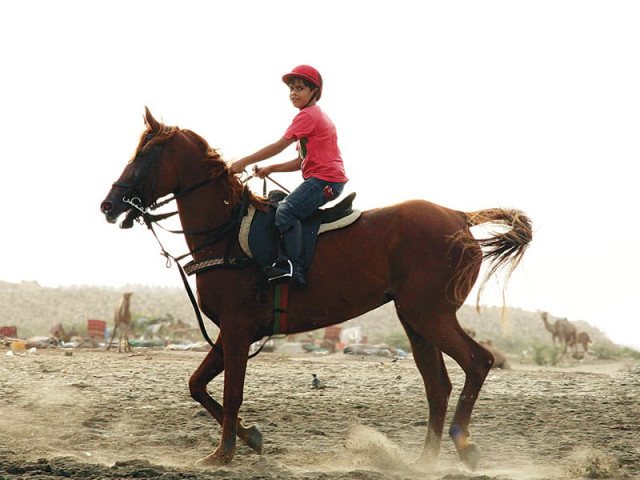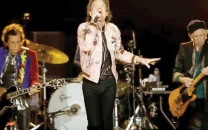In the saddle: Horse whisperer
Riding is a refreshing alternative to typical summer activities.

In the saddle: Horse whisperer
Becoming one with the horse is a distant dream for me, though, as I sit astride a large brown quadruped called MacDonald on a lonely corner of Karachi’s Clifton beach. I always thought that the most difficult thing about horse riding would be getting the horse to stop – I had envisioned hopelessly tugging on the reins while the horse carried me halfway to Balochistan. Turns out, the actual challenge is getting the horse to move at all, and I spend my first ten minutes in the saddle using all my powers of persuasion to kick MacDonald into high gear. I coo at the horse, nudge him, make kissy-noises at him, all to no avail. He just stands there flicking flies away with his ample mane, while Rafay stands chuckling a few feet from us.
“The horse can tell what you’re thinking,” explains Rafay as he begins to lead MacDonald around in a circle. “You have to look straight ahead and communicate to the horse with your grip and actions that this is where you want to go.”
All around me, young boys and girls clamber onto horses and slide off, dressed in riding boots and helmets. The Karachi Riding School, run by Rafay and his brother Haseeb Mehta, has been in operation for about four years. Rafay and his brother are both former polo players, and they teach children and adults alike how to ride horses. Some people sign up because they want to play polo professionally, some people just want to explore a unique activity, and I suppose some, like me, want to challenge their own notions of what constitutes acceptable adult behaviour.
Rafay says that horse riding is a tremendously underrated sport. “Horse riding improves the posture and confidence, is great for overall fitness, and really allows you to get close to nature,” he says. “It is especially great for children who are shy or who have difficulty communicating.” Before I climbed onto MacDonald, a little boy with a speech impediment was riding him. His mother, who was sitting under a little canopy erected for watchful parents, said she felt horse riding was helping build his confidence and his ability to focus. The boy himself seemed perfectly at home on the horse, and was busily shouting out instructions to the patient animal, seemingly unaffected by his slight lisp.
In Pakistan, according to Rafay, horse riding is also one of the few ‘paying’ sports, meaning that polo players are decently remunerated. However, Rafay does concede that it is very expensive to train players and actually run a private riding school. A huge amount of investment is needed to maintain the horses, most of which are bred locally.
The horses that canter around this deserted strip of sand seem docile and well-behaved, though this shouldn’t fool you into thinking that horse riding is a sport for the faint of heart. When I ask whether there have been any injuries at the training school, Rafay cheerfully replies that one student broke his arm in two places after falling off a horse, and another dislocated his shoulder during his very first riding lesson. Rafay adds that most injuries occur when a rider is mounting a horse, or dismounting.
Luckily, I had little trouble getting on the horse, thanks to a cement ‘step’ that was positioned next to MacDonald. And once I had finally got him moving, I thought “Hm, this is easy,” until Rafay pointed out that I was gripping the saddle with both hands rather than holding the reins. “Its instinct,” Rafay explains. “You feel more secure when you hold the saddle, but you’re supposed to use your knees and thighs to grip the horse. That is what will prevent you from falling, and will also guide the horse.”
The preferred posture for horse riding is stomach in, shoulders back, and back straight. You’re also meant to keep your knees tucked firmly into the horse’s sides, and press your heels down rather than pointing your toes towards the sand like a ballerina.
It’s harder than it sounds. After strolling along the sand while we chat, Rafay instructs the horse to trot, which leads to several minutes of being bounced painfully up and down in the saddle, which really should be cushioned better. Having not yet developed the skill or the thigh muscles needed to hold myself aloft in the saddle, I resign myself to my bruised fate, all the while enviously watching Haseeb race across the beach in a proficient crouch on his speedy steed.
And though horse riding doesn’t look particularly strenuous – I mean, the horse seems like he’s doing all the work – after I dismount my legs ache, and I feel like I have just been for a long jog. No wonder horse riding has become the new celebrity fitness trend of choice, with Madonna, Jodi Kidd, and even Kate Middleton um, jumping into the saddle.
So if you’re looking to take up a new sport that allows you to enjoy open spaces and the company of horse and human alike, give riding a shot. A fair warning - dealing with the sore bottom that results, is your problem.
Published in The Express Tribune, Sunday Magazine, July 17th, 2011.


















COMMENTS
Comments are moderated and generally will be posted if they are on-topic and not abusive.
For more information, please see our Comments FAQ